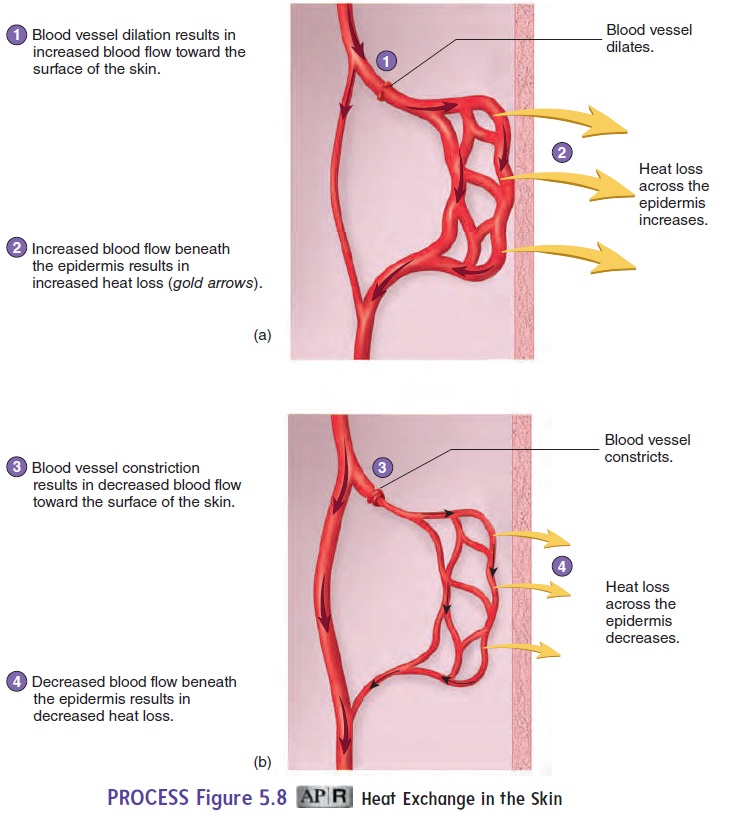Chapter: Essentials of Anatomy and Physiology: Integumentary System
Physiology of the integumentary system
Physiology of the integumentary system
Protection
The integumentary system performs many protective functions.
1.The intact skin plays an important role in reducing water loss because its lipids act as a barrier to the diffusion of water.
2.The skin prevents microorganisms and other foreign substances from entering the body. Secretions from skin glands also produce an environment unsuitable for some microorganisms.
3.The stratified squamous epithelium of the skin protects underlying structures against abrasion.
4.Melanin absorbs ultraviolet light and protects underlying structures from its damaging effects.
5. Hair provides protection in several ways: The hair on the head acts as a heat insulator, eyebrows keep sweat out of the eyes, eyelashes protect the eyes from foreign objects, and hair in the nose and ears prevents the entry of dust and other materials.
6.The nails protect the ends of the fingers and toes from damage and can be used in defense.
Sensation
Receptors in the epidermis and dermis can detect pain, heat, cold, and pressure . Although hair does not have a nerve supply, sensory receptors around the hair follicle can detect the movement of a hair.
Vitamin D Production
When the skin is exposed to ultraviolet light, a precursor molecule of vitamin D is formed. The precursor is carried by the blood to the liver, where it is modified, and then to the kidneys, where the precursor is modified further to form active vitamin D. If exposed to enough ultraviolet light, humans can produce all the vitamin D they need. However, many people need to ingest \vitamin D as well because clothing and indoor living reduce their exposure to ultravio-let light. Fatty fish (and fish oils) and vitamin D–fortified milk are the best sources of vitamin D. Eggs, butter, and liver contain small amounts of vitamin D but are not considered significant sources because too large a serving size is necessary to meet the daily vitamin D requirement. Adequate levels of vitamin D are necessary because active vitamin D stimulates the small intestine to absorb calcium and phosphate, the substances necessary for normal bone growth and normal muscle function .
Temperature regulation
Body temperature normally is maintained at about 37°C (98.6°F). Regulation of body temperature is important because the rate of chemical reactions within the body can be increased or decreased by changes in body temperature. Even slight changes in temperature can make enzymes operate less efficiently and disrupt the normal rates of chemical changes in the body.
Exercise, fever, and an increase in environmental temperature tend to raise body temperature. In order to maintain homeostasis, the body must rid itself of excess heat. Blood vessels in the dermis dilate and enable more blood to flow within the skin, thus transfer-ring heat from deeper tissues to the skin (figure 5.8a), where the heat is lost by radiation (infrared energy), convection (air move-ment), or conduction (direct contact with an object). Sweat that spreads over the surface of the skin and evaporates also carries away heat and reduces body temperature.
If body temperature begins to drop below normal, heat can be conserved by the constriction of dermal blood vessels, which reduces blood flow to the skin (figure 5.8b). Thus, less heat is trans-ferred from deeper structures to the skin, and heat loss is reduced. However, with smaller amounts of warm blood flowing through the skin, the skin temperature decreases. If the skin temperature drops below about 15°C (59°F), dermal blood vessels dilate.

PROCESS Figure 5.8 Heat Exchange in the Skin
Excretion
The integumentary system plays a minor role in excretion, the removal of waste products from the body. In addition to water and salts, sweat contains small amounts of waste products, such as urea, uric acid, and ammonia. Even though the body can lose large amounts of sweat, the sweat glands do not play a significant role in the excretion of waste products.
Related Topics